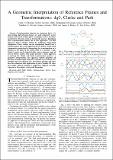A Geometric Interpretation of Reference Frames and Transformations: dq0, Clarke, and Park
Author(s)
O'Rourke, Colm Joseph; Qasim, Mohammad Mowafaq; Overlin, Matthew R; Kirtley Jr, James L
DownloadFinal_Submission__Open_Access.pdf (4.256Mb)
Terms of use
Metadata
Show full item recordAbstract
Transformations between abc, stationary dq0 (αβ0) and rotating dq0 reference-frames are used extensively in the analysis and control of three-phase technologies such as machines and inverters. Previous work on deriving the matrices describing these transformations follows one of two approaches. The first approach derives Clarke's matrix by modifying symmetrical components. Park's matrix can be subsequently found from a rotation matrix. The second approach derives Park's matrix using trigonometric projection by interpreting the transformation as a rotation in the plane of the cross-section of a machine. Then, Clarke's matrix can be found trivially using a reference angle of zero in Park's matrix. This paper presents a third approach to deriving the Clarke and Park transformation matrices: a geometric interpretation. The approach exploits properties of the linear transformation using the Cartesian representation. We introduce the locus diagram of a three-phase quantity and show how these diagrams have applications in power quality. We show that, unlike a phasor diagram, a single locus diagram can fully represent a three-phase system with harmonics.
Date issued
2019-12Department
Massachusetts Institute of Technology. Department of Electrical Engineering and Computer ScienceJournal
IEEE Transactions on Energy Conversion
Publisher
Institute of Electrical and Electronics Engineers (IEEE)
Citation
O'Rourke, Colm J. et al. "A Geometric Interpretation of Reference Frames and Transformations: dq0, Clarke, and Park." IEEE Transactions on Energy Conversion 34, 4 (December 2019): 2070 - 2083 © 2019 IEEE
Version: Author's final manuscript
ISSN
0885-8969
1558-0059